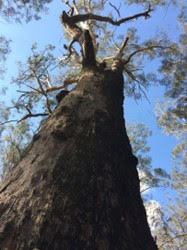Adapted from the TFNC July 2025 newsletter report of D. Pagel.
 |
Withcott Waterlilies
Photo: M. Simmons |
It was a clear winter’s day, and the temperature was much warmer below the Range when we met at our destination in Withcott. We strolled down a grassy slope past scattered Forest Red Gums Eucalyptus tereticornis where there was some evidence of koala activity in foliage and on bark, and past specimens of Soap Tree Alphitonia excelsa and Flat-stemmed Wattle Acacia complanata. The slope led to a large dam that was more like a picturesque billabong skirted by a path and fringed with Common Rush Juncus usitatus. On the water were a number of waterbirds, and patches of exotic Blue Water Lilies Nymphaea caerulea flowering on their tall stems. However, some flowers appeared larger, paler and to sit on the surface of the water. Surely, they were not the native Giant Water Lily Nymphaea gigantea, locally extinct, that years ago excited our Field Naturalists on outings to several locations on the Downs? (Yet to be confirmed.) |
Rodent droppings
Photo: L. Moodie |
We then moved on to an area of scrubby woodland on poor thin soil at Postmans Ridge. Here the Gatton Sandstone that had not been so conspicuous at our first stop demonstrated how friable and easily eroded it can be. Our sandy road became impassable because of deeply eroded channels, probably the result of tunnelling where the clayey subsoil contains sodium salts that dissolve or ‘melt away’ on wetting. On one side of this road, we noted stands of Black She-oak Allocasuarina littoralis and termite activity both on trees and in a prominent mound that was capped with the dark droppings of an unidentified species of rat. Those who walked on the other side noted Geebung Persoonia sp., Cough Bush Cassinia laevis and Sweet Canthium Psydrax odorata subsp. buxifolium. Acacias included Flat-stemmed Wattle Acacia complanata and Blake’s Wattle Acacia Blakei subsp. diphylla.
 |
Fungus Pisolithes sp.
Photo: D. Pagel |
Emerging from the road surface itself was a fresh specimen of the Horse Dung Fungus Pisolithus sp. that had been spared by many of our vehicles’ tyres. Its white globe would finally become dark brown and crumble when mature to reveal its spore mass. This fungus has been known to emerge on roadsides through bitumen.
Our final destination was Helidon Spa where Nats enjoyed lunch at the water’s edge while admiring large numbers of Plumed Whistling Ducks and the image of Little Corellas in a eucalypt, vivid white against an intense blue sky. Warm thanks to Melanie for organizing this enjoyable excursion.
 |
Little Corellas at Helidon Spa
Photo: M. Simmons |
Species Lists
Birds:
Withcott. Superb Fairy-wren, Magpie
Lark, Willie Wagtail, Common Myna, House Sparrow.
Postmans Ridge. Plumed
Whistling Duck, Australian Wood Duck, Pacific Black Duck, Hardhead, Australasian
Grebe, Crested Pigeon, Little Black Cormorant, White Faced Heron, Dusky
Moorhen, Pale-headed Rosella, Noisy Minor, Grey Butcherbird, Magpie-lark,
Welcome Swallow.
Helidon Spa. Plumed Whistling
Duck, Pacific Black Duck, Australasian Grebe, Dusky Moorhen, Straw-necked Ibis,
Masked Lapwing, Little Corella, Sulphur-crested Cockatoo, Pied Butcherbird,
Australian Magpie, Willie Wagtail.
Butterflies: Small
Green Banded Blue, Caper White, Common Grass Yellow, Wanderer (Monarch).


















